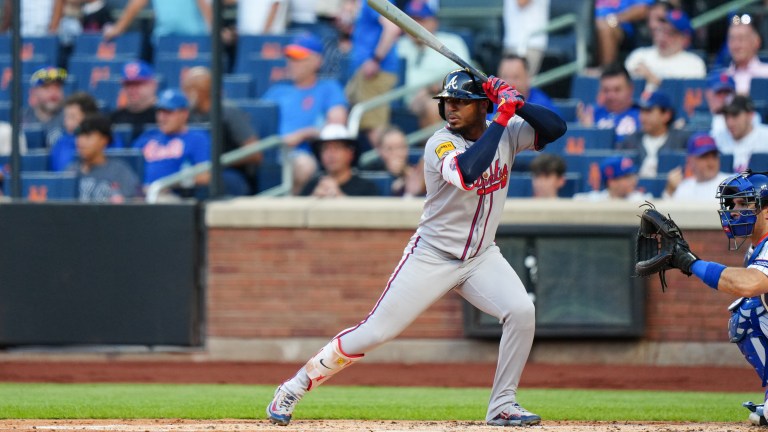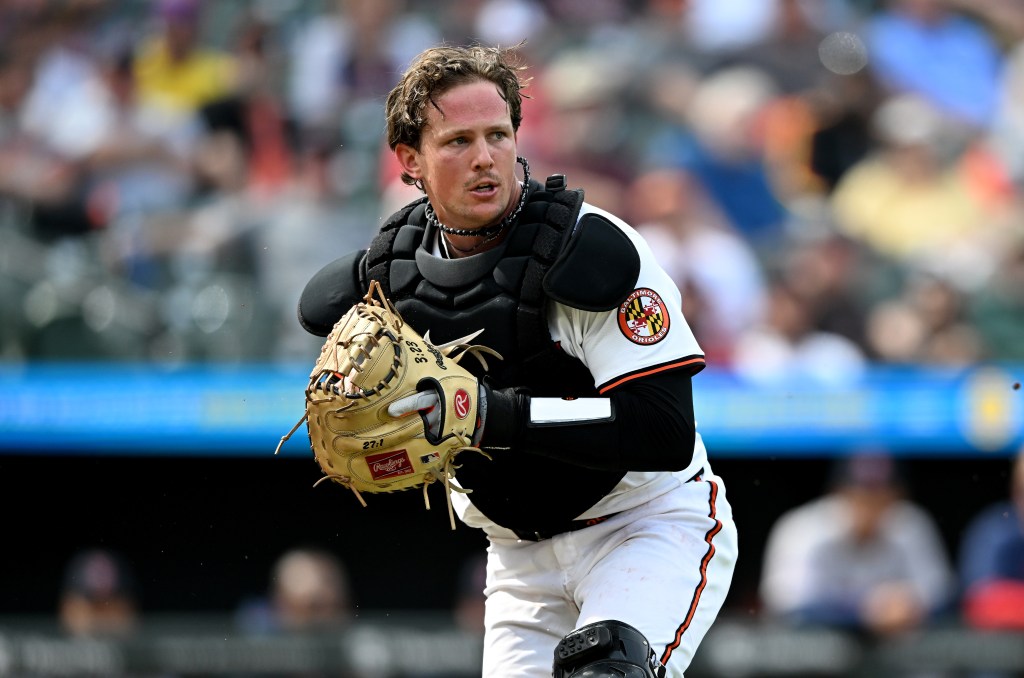Five Players Who Should Really Just Give Up on Switch-Hitting
Swinging the bat from both sides is a lost art in MLB. Let's take a closer look into a handful of switch-hitters who should drop that label.

Throughout the history of Major League Baseball, batters who can swing it from both sides of the plate have always been a work of art. Some of the best players of all-time were switch-hitters, including Hall of Famers Mickey Mantle, Eddie Murray, Ozzie Smith, and Chipper Jones.
In today’s game, finding switch-hitters is more rare than ever before. Sure, you’ve got the superstars doing it from both sides like Cal Raleigh, Francisco Lindor, Ketel Marte, and Jose Ramirez doing their thing. But the fact of the matter is that there have only been 62 players to register a plate appearance from both sides of the dish this year.
Weirdly enough, that figure of 62 is the dang close to how many did it last year (67). In 2025, 11 of them have less than 50 plate appearances and only 15 have enough to be qualified hitters.
Going even further, the St. Louis Cardinals have yet to have a single switch-hitter get an at-bat this year. Three teams last year (Detroit Tigers, Athletics, Houston Astros) didn’t have one all year long, and five more teams each had a grand total of one.
An article from FOX Sports published in May of 2022 pointed out that around 12.5% of players were switch-hitters at the time. This year, that’s down to around 9.35%.
Seeing some of the game’s best – like Raleigh, Lindor, Marte, and Ramirez – on a nightly basis is a treat. Each of them have an OPS+ at or over 100 this year from both sides of the plate.
On the flipside, there are quite a few players who continue to function as switch-hitters despite the fact that their numbers suggest they shouldn’t be.
All stats updated prior to games on Thursday, June 26
Not Every Switch-Hitter Should be a Switch-Hitter
Sure, being able to hit a home run from both the right and left side of the plate is a nice tool to have, but if you strikeout 50% of the time and can barely hit your body weight from one side, maybe it’s time to give it up.
In the not-so-distant past, there have been a few examples of players that dropped the “switch-hitter” label. This includes Cedric Mullins, who immediately became an All-Star, Tucker Barnhardt, and Shane Victorino. Ezequiel Tovar of the Colorado Rockies also came up as a switch-hitter but abandoned that in 2018.
Here, we take a closer look at a handful of switch-hitters who would be better off giving it up and hitting from their dominant side. A deep dive into the numbers suggests that there are more examples of this than you’d think.
Ozzie Albies
| Statistic | Vs. RHP | Vs. LHP |
| Batting Average | .245 (3,110 PA) | .327 (1,033 PA) |
| OBP | .309 | .353 |
| SLG | .430 | .540 |
| OPS | .739 | .893 |
| wRC+ | 95 | 136 |
Ozzie Albies has found himself at the forefront of these discussions for years now. Over the course of his career, he hasn’t been bad against right-handed pitching, but he’s clearly not as comfortable against them and as he is against southpaws.
At the tail end of last year, Albies was experiencing wrist discomfort when swinging it from the left side, so he batted exclusively as a right-hander upon his return from a stint on the IL. He posted a .724 OPS in 33 plate appearances down the stretch against righties as a righty.
It’s a bit hard to gauge where he’s at this year, because he’s been downright awful from both sides. Weirdly enough, he’s got a higher wRC+ (86) against right-handers than he does against left-handers (46), but that’s far different than what he’s shown in the past.
In recent years, Albies has been elite against left-handed pitching and decent against righties. That’s what’s prompted a lot of the talk amongst fans whether or not he should consider abandoning the switch-hitter label.
It’s a fair thought, because he’s been incredible against southpaws. It’s possible that he just reads the ball better coming out of a lefty’s hand, but it’s just as likely that he’s got a stronger swing from the right side. Fortunately for him, he’s not horrendous from either side of the plate (2025 aside…), so he’ll live if he doesn’t decide to make a change.
Elly De La Cruz

| Statistic | Vs. RHP | Vs. LHP |
| Batting Average | .275 (1,023 PA) | .214 (448 PA) |
| OBP | .352 | .281 |
| SLG | .516 | .342 |
| OPS | .868 | .622 |
| wRC+ | 130 | 67 |
You don’t need me to tell you this, but Elly De La Cruz is one of the most electric and bright young stars in today’s game. He’s got “future MVP” written all over him and it’s just so obvious at all times that he loves this game.
That De La Cruz is still able to produce the way he does while being a black hole offensively against left-handers says a lot about the amount of talent we’re dealing with here. He’s got a wRC+ of 80 against lefties this season which is better than his career numbers, but still 20% below league-average.
Having such a young superstar make a big switch like this is only possible if the player himself is willing to make the adjustment. Clearly the switch-hitting label isn’t holding him down too much, but it’s hard not to wonder where his numbers would be if he only hit from his dominant side.
Jasson Dominguez
| Statistic | Vs. RHP | Vs. LHP |
| Batting Average | .268 (241 PA) | .179 (111 PA) |
| OBP | .353 | .288 |
| SLG | .474 | .263 |
| OPS | .826 | .551 |
| wRC+ | 132 | 62 |
It feels like it’s been such a long time since Jasson Dominguez first broke into the league. After receiving scant playing time at the big-league level in 2023 and 2024, “The Martian” is getting everyday reps in left field now that Juan Soto has moved on and he’s having a respectable season so far.
Dominguez is in his first full season at the major-league level and is at the beginning stages of what’s going to be a long and successful career there. However, it’s already apparent that he’s not going to fare well against left-handed pitching, so why not make the change now before he accumulates years of subpar statistics against southpaws?
With many players, especially one as young as Dominguez, it could be a dangerous game to take his switch-hitting capabilities away and then throw him to the wolves against a nasty left-handed breaking ball. It helps that he’s got decent plate discipline as a right-handed batter, but it feels like these splits are only going to become harder to ignore as his career marches on. If he intends to stick as a switch-hitter, he’s got some work to do.
Jonah Heim
| Statistic | Vs. RHP | Vs. LHP |
| Batting Average | .217 (1,488 PA) | .264 (494 PA) |
| OBP | .274 | .310 |
| SLG | .361 | .441 |
| OPS | .635 | .751 |
| wRC+ | 76 | 108 |
Remember back in 2023 when Heim randomly turned into one of the better power-hitting backstops in baseball? Since then, his numbers have steadily declined, and he’s currently mired in a second consecutive below-average season. To his credit, though, he’s at least hitting better this year than he did last.
Heim is yet another example of a switch-hitter who should drop the label. Similarly to Dominguez, Heim has basically the exact same sense of plate discipline on both sides of the dish, but he hits for much less power and clearly isn’t quite as comfortable as a left-handed hitter.
In his breakout season a few years back, Heim posted a 98 wRC+ against righties but it dipped to 64 last year and is currently at 84 this year. Making things even weirder, he’s got a 64 wRC+ against lefties this year which flip-flops his career norms. Who knows what to make of him at this point.
Adley Rutschman

| Statistic | Vs. RHP | Vs. LHP |
| Batting Average | .247 (1,499 PA) | .283 (572 PA) |
| OBP | .336 | .376 |
| SLG | .408 | .433 |
| OPS | .743 | .809 |
| OPS+ | 112 | 133 |
Alright, alright, be nice to me here.
Rutschman, 27, has been gradually coming down from his outstanding rookie campaign in 2022 and is basically at an all-time low this year. The backstop was at one point viewed as one of the Orioles’ top building blocks and best catchers in baseball, but he looks so much different now than he did to start things off.
Historically, Rutschman has performed well against all pitchers, regardless of their handedness. In 2025, he’d been mired in a funk before he went on the shelf recently with a left oblique strain. He was “just okay” in the first month of the season, dreadful in May and was turning things around in a big way in the month of June before hitting the shelf.
Rutschman’s shown two very different sides of himself this year, so a change could make some degree of sense here if he comes back and reverts back to his last checkpoint from May.
This season, he’s got a 123 wRC+ against left-handed pitching, and he’s walked basically the same amount as he’s struck out. Against righties he’s hit for a bit more power, but his wRC+ is down to 90, or 10% below league-average. Again, this is depending on how he looks when he returns form the shelf, but dropping his left-handed swing could help him shift his focus to what’s always been his strong side.
Either way, something’s got to give here and Rutschman’s got to find a way to claw his way back to the path to superstardom.
